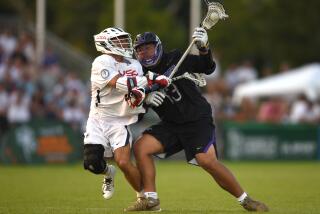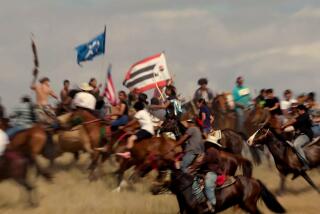Iroquois are returning to their field of dreams : Team to play lacrosse on the world level, 100 years after being banned.
- Share via
ONONDAGA NATION TERRITORY, N.Y. — Donna Bucktooth’s home is typical of those on this 7,300-acre reservation in the rolling, thickly wooded hills of central New York, just south of Syracuse.
A forest of lacrosse sticks sprout from a container near the kitchen. Dozens of glittering lacrosse trophies fill a showcase in the sunny family room. In the backyard, a small practice field is laid out with a net-draped goalie cage at either end.
“Lacrosse is a way of life with the Iroquois,” the bright-eyed grandmother said proudly. “My grandfather played lacrosse, my father played, my son played and now my five grandchildren play. All these things you see--the sticks, the trophies, the practice area--are theirs.”
That way of life is getting a big boost these days. More than a century ago, the Iroquois were barred from international competition in the sport that their ancestors helped invent--because, they say, they were too good at it. Now, for the first time since then, a team representing the six-nation Iroquois Confederacy is preparing to play in officially sanctioned world amateur lacrosse.
Twenty-six players from the Iroquois Nationals lacrosse squad--a 7-year-old team whose members come from the Onondaga, Mohawk, Oneida, Cayuga, Seneca and Tuscarora nations that make up the Iroquois Confederacy--are carrying the Iroquois flag to the quadrennial World Games, which will open this weekend in Perth, Australia.
The Iroquois have long yearned to return to international lacrosse competition. When their white-and-purple flag with its wampum belt emblem is unfurled along with the banners of the United States, Canada, Britain and Australia, it will mark what many Iroquois see as the opening of a new era.
“It represents not only our re-entry into the international games but the continuity of our people and a look into our future,” said Oren Lyons Jr., 60, an Onondaga chief who is himself a former college All-American lacrosse player and a founding father of the Iroquois Nationals. “Lacrosse is the lifeblood of the Iroquois,” he added. “Now, our young people have something to aim at.”
Among team members of the Iroquois Nationals themselves, pure delirium reigns. “It’s a once-in-a-lifetime opportunity,” said Daniel Burnham, a 19-year-old Onondaga who attends Loyola College of Maryland. “I never thought I’d travel so far. Now I’m doing it through lacrosse.”
It was in the 1880s that the Iroquois--who call themselves “Haudenosaunee,” or “People of the Long Houses,” and who believe that lacrosse is a special gift to them from the Creator--were banished from international competition for alleged “professionalism.”
Up to then, Iroquois teams routinely played with whites in the United States and Canada after whites took up the game in the mid-19th Century.
“The same thing happened to Jim Thorpe,” said Irving Powless Jr., an Onondaga chief whose son Barry is part of the team going to Australia. “We were too good for them. We were beating the white teams all the time. So they decided it was time to get us out of the game.”
In 1983, however, the Iroquois Nationals were formed to recapture the confederacy’s place in world games.
It was rough going at first. For one thing, field lacrosse--the form of the game played in such competitions--had long gone out of fashion among the Iroquois.
They generally played a form of the game called box lacrosse, which is played by teams of six players instead of 10 on a smaller court with shorter sticks. Box lacrosse encourages an aggressive style of attack, individual moves and high scoring with little thought of defense.
However, they have come a long way, and now they win far more exhibitions than they lose.
At the Onondaga reservation, Chief Powless spoke for the many Iroquois when he said: “It’s not important that they win in Australia. They only have to make a good showing. The very fact that we’re finally back in international competition as a full-fledged member of the international lacrosse federation is triumph enough.”


